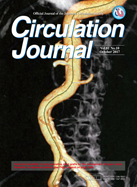81 巻, 10 号
選択された号の論文の31件中1~31を表示しています
- |<
- <
- 1
- >
- >|
Message From the Editor-in-Chief
-
原稿種別: MESSAGE FROM THE EDITOR-IN-CHIEF
2017 年 81 巻 10 号 p. 1377-1378
発行日: 2017/09/25
公開日: 2017/09/25
[早期公開] 公開日: 2017/09/13PDF形式でダウンロード (334K) HTML形式で全画面表示
Reviews
-
原稿種別: REVIEW
2017 年 81 巻 10 号 p. 1379-1385
発行日: 2017/09/25
公開日: 2017/09/25
[早期公開] 公開日: 2017/09/02PDF形式でダウンロード (1522K) HTML形式で全画面表示
Editorials
-
原稿種別: EDITORIAL
2017 年 81 巻 10 号 p. 1386-1387
発行日: 2017/09/25
公開日: 2017/09/25
[早期公開] 公開日: 2017/06/03PDF形式でダウンロード (485K) HTML形式で全画面表示
Original Articles
Aortic Disease
-
原稿種別: ORIGINAL ARTICLE
専門分野: Aortic Disease
2017 年 81 巻 10 号 p. 1388-1394
発行日: 2017/09/25
公開日: 2017/09/25
[早期公開] 公開日: 2017/04/25PDF形式でダウンロード (655K) HTML形式で全画面表示
Arrhythmia/Electrophysiology
-
原稿種別: ORIGINAL ARTICLE
専門分野: Arrhythmia/Electrophysiology
2017 年 81 巻 10 号 p. 1395-1402
発行日: 2017/09/25
公開日: 2017/09/25
[早期公開] 公開日: 2017/05/25PDF形式でダウンロード (586K) HTML形式で全画面表示 -
原稿種別: ORIGINAL ARTICLE
専門分野: Arrhythmia/Electrophysiology
2017 年 81 巻 10 号 p. 1403-1410
発行日: 2017/09/25
公開日: 2017/09/25
[早期公開] 公開日: 2017/05/25PDF形式でダウンロード (910K) HTML形式で全画面表示 -
原稿種別: ORIGINAL ARTICLE
専門分野: Arrhythmia/Electrophysiology
2017 年 81 巻 10 号 p. 1411-1428
発行日: 2017/09/25
公開日: 2017/09/25
[早期公開] 公開日: 2017/05/26PDF形式でダウンロード (2458K) HTML形式で全画面表示
Cardiovascular Intervention
-
原稿種別: ORIGINAL ARTICLE
専門分野: Cardiovascular Intervention
2017 年 81 巻 10 号 p. 1419-1423
発行日: 2017/09/25
公開日: 2017/09/25
[早期公開] 公開日: 2017/05/11PDF形式でダウンロード (540K) HTML形式で全画面表示
Cardiac Rehabilitation
-
原稿種別: ORIGINAL ARTICLE
専門分野: Cardiac Rehabilitation
2017 年 81 巻 10 号 p. 1424-1431
発行日: 2017/09/25
公開日: 2017/09/25
[早期公開] 公開日: 2017/05/11PDF形式でダウンロード (421K) HTML形式で全画面表示
Cardiovascular Surgery
-
原稿種別: ORIGINAL ARTICLE
専門分野: Cardiovascular Surgery
2017 年 81 巻 10 号 p. 1432-1438
発行日: 2017/09/25
公開日: 2017/09/25
[早期公開] 公開日: 2017/04/29PDF形式でダウンロード (644K) HTML形式で全画面表示
Epidemiology
-
原稿種別: ORIGINAL ARTICLE
専門分野: Epidemiology
2017 年 81 巻 10 号 p. 1439-1446
発行日: 2017/09/25
公開日: 2017/09/25
[早期公開] 公開日: 2017/04/29PDF形式でダウンロード (502K) HTML形式で全画面表示 -
原稿種別: ORIGINAL ARTICLE
専門分野: Epidemiology
2017 年 81 巻 10 号 p. 1447-1453
発行日: 2017/09/25
公開日: 2017/09/25
[早期公開] 公開日: 2017/05/30PDF形式でダウンロード (328K) HTML形式で全画面表示
Hypertension and Circulatory Control
-
原稿種別: ORIGINAL ARTICLE
専門分野: Hypertension and Circulatory Control
2017 年 81 巻 10 号 p. 1454-1462
発行日: 2017/09/25
公開日: 2017/09/25
[早期公開] 公開日: 2017/04/26PDF形式でダウンロード (680K) HTML形式で全画面表示
Imaging
-
原稿種別: ORIGINAL ARTICLE
専門分野: Imaging
2017 年 81 巻 10 号 p. 1463-1468
発行日: 2017/09/25
公開日: 2017/09/25
[早期公開] 公開日: 2017/05/18PDF形式でダウンロード (806K) HTML形式で全画面表示 -
原稿種別: ORIGINAL ARTICLE
専門分野: Imaging
2017 年 81 巻 10 号 p. 1469-1476
発行日: 2017/09/25
公開日: 2017/09/25
[早期公開] 公開日: 2017/05/23PDF形式でダウンロード (526K) HTML形式で全画面表示
Ischemic Heart Disease
-
原稿種別: ORIGINAL ARTICLE
専門分野: Ischemic Heart Disease
2017 年 81 巻 10 号 p. 1477-1483
発行日: 2017/09/25
公開日: 2017/09/25
[早期公開] 公開日: 2017/04/25PDF形式でダウンロード (779K) HTML形式で全画面表示 -
原稿種別: ORIGINAL ARTICLE
専門分野: Ischemic Heart Disease
2017 年 81 巻 10 号 p. 1484-1489
発行日: 2017/09/25
公開日: 2017/09/25
[早期公開] 公開日: 2017/04/27PDF形式でダウンロード (487K) HTML形式で全画面表示 -
原稿種別: ORIGINAL ARTICLE
専門分野: Ischemic Heart Disease
2017 年 81 巻 10 号 p. 1490-1495
発行日: 2017/09/25
公開日: 2017/09/25
[早期公開] 公開日: 2017/05/17PDF形式でダウンロード (469K) HTML形式で全画面表示 -
原稿種別: ORIGINAL ARTICLE
専門分野: Ischemic Heart Disease
2017 年 81 巻 10 号 p. 1496-1505
発行日: 2017/09/25
公開日: 2017/09/25
[早期公開] 公開日: 2017/05/23PDF形式でダウンロード (1317K) HTML形式で全画面表示 -
原稿種別: ORIGINAL ARTICLE
専門分野: Ischemic Heart Disease
2017 年 81 巻 10 号 p. 1506-1513
発行日: 2017/09/25
公開日: 2017/09/25
[早期公開] 公開日: 2017/05/25PDF形式でダウンロード (662K) HTML形式で全画面表示 -
原稿種別: ORIGINAL ARTICLE
専門分野: Ischemic Heart Disease
2017 年 81 巻 10 号 p. 1514-1521
発行日: 2017/09/25
公開日: 2017/09/25
[早期公開] 公開日: 2017/06/13PDF形式でダウンロード (976K) HTML形式で全画面表示
Pediatric Cardiology and Adult Congenital Heart Disease
-
原稿種別: ORIGINAL ARTICLE
専門分野: Pediatric Cardiology and Adult Congenital Heart Disease
2017 年 81 巻 10 号 p. 1522-1527
発行日: 2017/09/25
公開日: 2017/09/25
[早期公開] 公開日: 2017/05/17PDF形式でダウンロード (384K) HTML形式で全画面表示
Vascular Biology and Vascular Medicine
-
原稿種別: ORIGINAL ARTICLE
専門分野: Vascular Biology and Vascular Medicine
2017 年 81 巻 10 号 p. 1528-1536
発行日: 2017/09/25
公開日: 2017/09/25
[早期公開] 公開日: 2017/09/05PDF形式でダウンロード (914K) HTML形式で全画面表示
Rapid Communications
-
原稿種別: RAPID COMMUNICATION
2017 年 81 巻 10 号 p. 1537-1539
発行日: 2017/09/25
公開日: 2017/09/25
[早期公開] 公開日: 2017/08/24PDF形式でダウンロード (295K) HTML形式で全画面表示 -
原稿種別: RAPID COMMUNICATION
2017 年 81 巻 10 号 p. 1540-1542
発行日: 2017/09/25
公開日: 2017/09/25
[早期公開] 公開日: 2017/08/24PDF形式でダウンロード (362K) HTML形式で全画面表示 -
原稿種別: RAPID COMMUNICATION
2017 年 81 巻 10 号 p. 1543-1546
発行日: 2017/09/25
公開日: 2017/09/25
[早期公開] 公開日: 2017/08/31PDF形式でダウンロード (387K) HTML形式で全画面表示
Images in Cardiovascular Medicine
-
原稿種別: IMAGES IN CARDIOVASCULAR MEDICINE
2017 年 81 巻 10 号 p. 1547-1549
発行日: 2017/09/25
公開日: 2017/09/25
[早期公開] 公開日: 2017/03/31PDF形式でダウンロード (681K) HTML形式で全画面表示 -
原稿種別: IMAGES IN CARDIOVASCULAR MEDICINE
2017 年 81 巻 10 号 p. 1550-1552
発行日: 2017/09/25
公開日: 2017/09/25
[早期公開] 公開日: 2017/03/31PDF形式でダウンロード (642K) HTML形式で全画面表示 -
原稿種別: IMAGES IN CARDIOVASCULAR MEDICINE
2017 年 81 巻 10 号 p. 1553-1555
発行日: 2017/09/25
公開日: 2017/09/25
[早期公開] 公開日: 2017/03/31PDF形式でダウンロード (624K) HTML形式で全画面表示
-
2017 年 81 巻 10 号 p. Cover10-
発行日: 2017年
公開日: 2017/09/25
PDF形式でダウンロード (2092K) -
2017 年 81 巻 10 号 p. Content10-
発行日: 2017年
公開日: 2017/09/25
PDF形式でダウンロード (512K)
- |<
- <
- 1
- >
- >|
